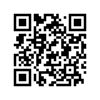What are the secrets behind these curious symbols? As it often happens, a midweek tweet among thousands sparks a further exchange of questions, observations and comments. Which then goes on to gather more participants, more viewpoints, and ultimately - it becomes the topic of a Twitter chat, especially when it catches the watchful eyes of the Church Social Media group (check the #ChSocM hashtag on Twitter and their website).
Which synod has QR codes posted for their assembly? Nebraska. Bam. #missionpossibleELCA twitter.com/Sarcasticluthe…— Nadia Bolz-Weber (@Sarcasticluther) May 31, 2013
What started out as a hat tip (HT, in Twitter shorthand) turned into a rather informative discussion about the acceptance of QR codes, ways to improve their acceptance and effectiveness, and some of the ways they have been used, with and without success. This post will begin to unravel this mysterious 'new' technology and its use for communicating your message.
A quick little primer about QR (Quick Response) codes. QR codes have been around for almost 20 years, having been invented by a Toyota subsidiary in 1994. They are 2-dimensional, where typical barcodes are only 1-dimensional, and can store much greater amounts of information in a variety of formats. They can represent web addresses, plain text, contact information, phone numbers, email addresses, geographic location coordinates, even details for connecting to wireless networks. To read a QR code, you need a image capturing device (like the camera in your smartphone) and an application (app) that can decode them.
The #ChSocM chat focused on the familiarity, acceptance and creative ways to use them - what will it take to move "scorners" to "scanners"? Is this something to keep on your radar? Are we late to the dance?
The topics:
T1: Are you a QR code "scanner" or "scorner"?
T1a: Scanners, what context compels you to scan
T2: How have you used QR codes in #chsocm ?
T2b: Scanners/advocates: what's the best use of a QRCode you've used or experienced?
T2c: Scorners - what could make QRCodes more compelling for you?
T3: Name one way you could use a QRCode in #chsocm that you're not currently using one for
The chat packed a lot of data into a very fast-moving 1-hour exchange, so unpacking it and bringing it all into perspective takes a bit of doing. Several people lingered after the chat to continue their own discussion, bleeding over into the next few days. Here's the high-level overview -
The use of QR codes (and many other communication pieces) boils down to 5 things:
- Who's likely to scan QR codes
- Why people scan QR codes
- Where the QR codes are placed
- What the codes point to
- What you want to happen next
In most contexts, QR codes are going to be scanned by someone with their smartphone. They need a reason to scan and will have the expectation that the result of the scan will add value to their current activity. They also expect it to be quicker than other means of accessing the information.
Just recently, the United States reached a point where over 1/2 of the adult population has a smartphone - do they all scan QR codes? No. Many don't even know their phones are capable of scanning them. Only 1 in 5 have scanned a QR code in the last 30 days. The majority will need to be educated about QR codes - first, that they can scan them and, second, how to scan them.
After they know they can and they know how, they need to know why.
Now that you have placed yourselves in their shoes, you are getting smarter about where you'll place your QR codes. You'll also be smarter about the target of the codes.
First, the target. By far, the biggest use of QR codes is to provide a link to online resources - usually a web page or a download (from a web page). Which requires --- Internet access, preferrably over wifi. Are you providing it for them?
Remember how they are accessing this resource on the Internet? With their smartphone. Just how does that web page look on a mobile device? If you are providing a download, will it be something they can view or access on their mobile device? Have you removed all the barriers to accessing the online resource? Did that code get them to exactly where they needed to be, or were there additional steps they needed to take (click here, do this, sign in)?
What you want to happen next is really your motivation, since it ties directly to your mission and strategy.



 Fri 07 June 2013
Fri 07 June 2013 




